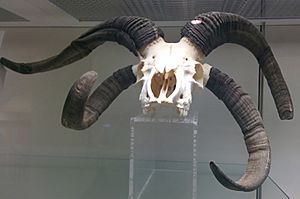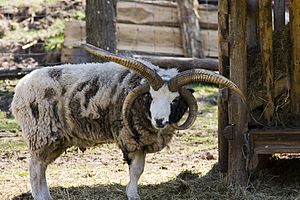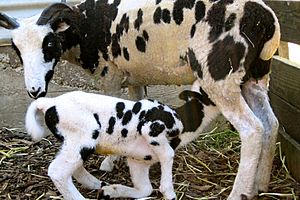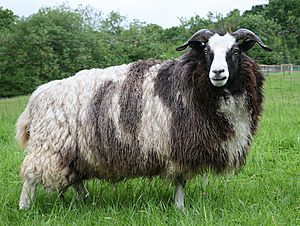Jacob sheep facts for kids
The Jacob is a special kind of domestic sheep from Britain. It's known for two unusual things: it has a spotted coat (called piebald) with dark and white wool, and it often has many horns, usually four!
People aren't sure exactly where this breed came from. But we know that spotted, multi-horned sheep were living in England by the mid-1600s and became quite common a century later. A special group called the Jacob Sheep Society was started in 1969 to protect and promote the breed.
For hundreds of years, Jacob sheep were kept as "park sheep" to make big estates look pretty. Today, they are mostly raised for their soft wool, tasty meat, and useful skins.
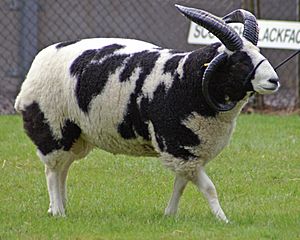
Ram at the Royal Show at Stoneleigh Park, Warwickshire
|
|
| Conservation status |
|
|---|---|
| Other names | Spanish Sheep |
| Country of origin | United Kingdom |
| Standard | Jacob Sheep Society |
| Traits | |
| Weight |
|
| Wool colour | piebald – black or grey with white patches |
| Face colour | badger-faced – black cheeks and muzzle, white blaze |
| Horn status | horned in both sexes; may have two or four horns |
|
|
Contents
History of the Jacob Sheep
The exact start of the Jacob sheep breed is a bit of a mystery. These sheep have lived in the British Isles for many hundreds of years. Paintings from around 1760 show sheep that look very much like today's Jacob sheep.
One old story says that these spotted sheep came to Ireland from a wrecked ship of the Spanish Armada in 1588. Then, they were brought to England.
The Jacob sheep got its name in the 20th century. This was because of a story in the Hebrew Bible (also called the Old Testament). In the Book of Genesis, a man named Jacob bred speckled and spotted sheep. Because these sheep look similar to the ones described in the Bible, they were given the name "Jacob." However, experts say this is just a coincidence. The breed was not originally from ancient Israel.
For a long time, the Jacob sheep was called the "Spanish sheep." It has been bred in England for at least 350 years. By the mid-1700s, spotted sheep were common in England. Rich landowners liked to keep Jacob sheep on their large estates as decorations. They kept importing these sheep, which helped the breed survive.
A group called the Jacob Sheep Society was created in July 1969. Mary Cavendish, Duchess of Devonshire, who had Jacob sheep at her home, was the first president. The society started keeping a record of all the Jacob sheep in 1972.
Jacob sheep first came to North America in the early 1900s. They were quite rare there until the 1980s. In 2016, a small group of about 120 Jacob sheep was brought to Israel from Canada.
How Many Jacob Sheep Are There?
In 2012, there were about 5,638 Jacob sheep in the UK. About 2,349 of these were breeding females. In 2017, the Rare Breeds Survival Trust put the Jacob sheep in Category 6 of its watchlist. This means there are more than 3,000 breeding females, so the breed is not at risk of disappearing.
Small numbers of Jacob sheep are also found in the Czech Republic, Germany, the Netherlands, and the United States. In some of these countries, they are still considered rare or endangered.
What Jacob Sheep Look Like
The Jacob is a small, spotted sheep with many horns. It looks a bit like a goat. But it's not the only breed that can have spots or multiple horns. Other sheep breeds with many horns include the Hebridean and Icelandic sheep. Other spotted breeds include the Finnsheep and Shetland Sheep.
Adult male Jacob sheep, called rams, usually weigh about 54 to 82 kg (120 to 180 lb). Adult females, called ewes, weigh about 36 to 54 kg (80 to 120 lb). They have long bodies with straight backs. Their heads are thin and triangular, with no wool on the front or cheeks. Their tails are long and woolly. Jacob sheep usually have white legs with or without dark spots. Their hooves are black or striped.
Jacob sheep give lean meat with little fat. This means they produce a lot of meat compared to other breeds.
Their Horns
The most unique thing about Jacob sheep is their horns. They usually have four horns, but they can have two or even six! Both male and female Jacob sheep always have horns. The rams' horns are usually bigger and more impressive.
Two-horned rams often have horns that curl horizontally. Four-horned rams have two tall horns that can be 61 cm (2 ft) or longer. They also have two smaller horns that grow down the sides of their heads. Ewes have smaller, thinner horns than rams.
The horns are usually black, but they can also be striped black and white. White horns are not preferred. Ideally, the horns are smooth and grow in a way that doesn't block the sheep's sight or make it hard for them to eat.
Their Markings
Each Jacob sheep has unique spots. This helps shepherds tell them apart from a distance. A good Jacob sheep usually has about 60% white wool and 40% black or brownish-gray spots. The skin under the white wool is pink, while the skin under the colored spots is dark.
Jacob sheep have certain markings that are typical for the breed. These include large, dark patches around their ears, eyes, and cheeks. They also have a dark "cape" over their neck and shoulders. Their face should have a white stripe, called a blaze, running from the top of their head down to their nose. The nose itself should be dark. This classic Jacob face is often called "badger-faced." Other random spots can appear on their body and legs.
Health of Jacob Sheep
Jacob sheep can sometimes get rare health problems.
One problem is called split eyelid. This is a birth defect common in several multi-horned British sheep breeds. It's linked to the gene for having many horns. In mild cases, the eyelid just has a small "peak." But in severe cases, the upper eyelid can be completely split in the middle.
In 2008, scientists found a disease in four Jacob lambs that is similar to Tay–Sachs disease in humans. This discovery might help find new ways to treat the disease in people.
How Jacob Sheep Are Raised
Jacob sheep are often called an "unimproved" or "heirloom" breed. This means they have been left to breed naturally for a long time. They still have many of their original wild traits. American Jacob sheep have not been changed much by breeding, except for their wool. This means they look very similar to their ancestors.
However, British Jacob sheep have been bred to produce more meat. So, they tend to be larger and look more alike. This means the British Jacob sheep has changed more from its original form than the American Jacob sheep.
Jacob sheep are usually strong and don't need a lot of care. They are naturally good at resisting parasites and hoof problems. They don't tend to stick together in big groups like some other sheep breeds. They can be a bit shy if they're not used to people. But if you handle them every day, they can become friendly pets.
They need some shelter from very hot or cold weather, but a simple open shelter is fine. They do well in both hot and cold climates. They are also good at finding their own food, even in poor soil.
Jacob ewes are known for having easy births. They usually have lambs in the spring. Their first lamb is often a single one. After that, they usually have one or two lambs, and sometimes even three! The lambs are born with their spots and horn bumps already visible. Jacob ewes are very good mothers and protect their lambs. Farmers in England like to include them in their flocks because they are easy to lamb and are good mothers.
What Jacob Sheep Are Used For
Wool and Skins
Jacob sheep are usually shorn (their wool is cut off) once a year, often in the spring. The wool from one sheep usually weighs about 2–2.5 kg (4–6 lb). The wool is medium to coarse. It has a length of about 8–15 cm (3–6 in).
The wool is generally light, soft, and bouncy. It doesn't have much lanolin (grease). Sometimes, the black wool can be longer or shorter than the white wool. This is called "quilted fleece" and is not preferred.
Jacob sheep have a medium-grade wool. Their lambs are born with a protective coat that helps against rain and cold. This coat falls off when they are 3 to 6 months old.
The wool is shiny and very popular with people who spin yarn by hand. The different colored wools can be separated or mixed after shearing to make various shades of yarn, from almost white to almost black. Jacob sheepskins, once tanned, also sell for good prices.
See also
 In Spanish: Jacob (oveja) para niños
In Spanish: Jacob (oveja) para niños


